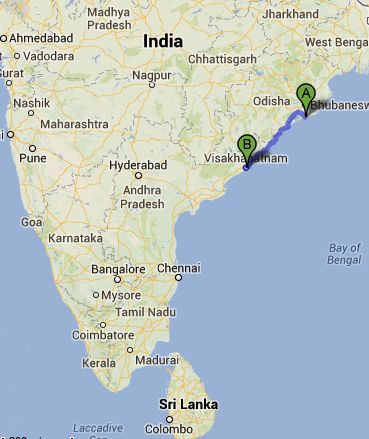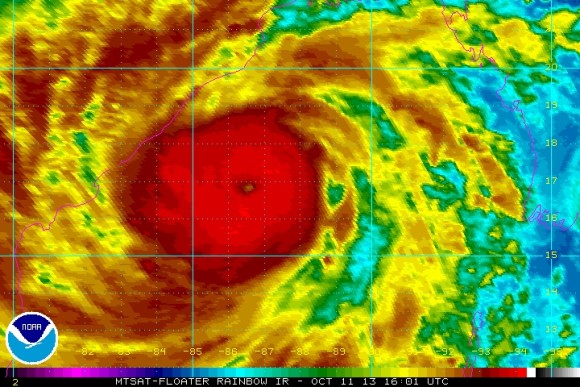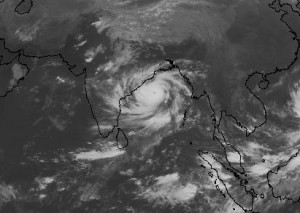Be prepared for the superstorm "Phailin" striking the South-East coasts!
Phailin has the potential to be one of the deadliest storms on Earth for the past several decades. It’ll strike India’s east coast within the next 24 hours.
The Cyclone Phailin is about half-INDIA'S size! Then think how much destruction it can cause.
 Cyclone Phailin is a very severe cyclonic storm that has affected Thailand, Myanmar and the Indian provinces of the Andaman and Nicobar Islands, Orissa, Andhra Pradesh and West Bengal. The system was first noted as a tropical depression within the Gulf of Thailand, to the west of Ho Chi Minh City in Vietnam.
Over the next few days, the system moved westwards within an area of
low to moderate vertical wind shear, before as it passed over the Malay
Peninsula, it moved out of the Western Pacific Basin on October 6. The
system emerged into the Andaman Sea during the next day and moved
west-northwest into an improving environment for further development.
The system was subsequently named Phailin on October 9, after it had
developed into a cyclonic storm and passed over the Andaman and Nicobar
Islands into the Bay of Bengal. After it was named, Phailin rapidly
intensified and developed an eye, and became a very severe cyclonic
storm on October 10, equivalent to a category 1 hurricane on the Saffir-Simpson hurricane wind scale (SSHWS).
Later that day, Phailin became equivalent to a category 4 hurricane on
the SSHWS before it underwent an eyewall replacement cycle and formed a
new eyewall early on October 11. This new eyewall subsequently
consolidated and allowed the system to intensify and become equivalent
to a category 5 hurricane on the SSHWS later that day.
Cyclone Phailin is a very severe cyclonic storm that has affected Thailand, Myanmar and the Indian provinces of the Andaman and Nicobar Islands, Orissa, Andhra Pradesh and West Bengal. The system was first noted as a tropical depression within the Gulf of Thailand, to the west of Ho Chi Minh City in Vietnam.
Over the next few days, the system moved westwards within an area of
low to moderate vertical wind shear, before as it passed over the Malay
Peninsula, it moved out of the Western Pacific Basin on October 6. The
system emerged into the Andaman Sea during the next day and moved
west-northwest into an improving environment for further development.
The system was subsequently named Phailin on October 9, after it had
developed into a cyclonic storm and passed over the Andaman and Nicobar
Islands into the Bay of Bengal. After it was named, Phailin rapidly
intensified and developed an eye, and became a very severe cyclonic
storm on October 10, equivalent to a category 1 hurricane on the Saffir-Simpson hurricane wind scale (SSHWS).
Later that day, Phailin became equivalent to a category 4 hurricane on
the SSHWS before it underwent an eyewall replacement cycle and formed a
new eyewall early on October 11. This new eyewall subsequently
consolidated and allowed the system to intensify and become equivalent
to a category 5 hurricane on the SSHWS later that day. Officials said around 12 million people may be affected, 600 buildings have been identified as cyclone shelters, and people are being evacuated from areas near the coast, including Ganjam, Puri, Khordha and Jagatsinghapur districts in Orissa.

Cyclone Phailin is a major hurricane (specified as a Super Cyclonic Storm) with wind speeds at 160 miles per hour, making it a Category 5 storm on the Saffir Simpson scale. The storm is not projected to weaken much as it slams into parts of eastern India late Saturday according to Indian clocks (Saturday morning U.S. time). The last time a Category 4 or 5 storm struck the eastern coast of India was back in 1999, when Cyclone Odisha struck killing over 10,000 people. A major disaster appears to be in the making, with at least one Indian meteorologist commenting that Phailin has the potential to be “worse than Katrina.”
Indeed, Phailin has the potential to be one of the deadliest storms on Earth for the past several decades. Phailin is expected to make landfall in northeast India, approximately between Visakhapatnam and Puri, within the next 24 hours.
Cyclone Phailin is currently spinning away in the Bay of Bengal. It is a large cyclone and is almost covering up nearly all of the Bay of Bengal. The last time a Category 4 or 5 storm struck the eastern coast of India was back in 1999, when Cyclone Odisha struck killing over 10,000 people. The residents that live off the coast of India are vulnerable to storm surge, flooding, and extreme damage from tropical cyclones. If you throw into the mix a Category 4 or 5 storm, that spells major problems. The storm is super large, meaning storm surge will likely be greater.
Phailin has already had an eyewall replacement cycle, meaning that it could intensify prior to making landfall in eastern India. The storm is very symmetric and is going over very warm waters and perfect atmospheric conditions that are very favorable for an intensifying storm.
Cyclone formation in the Northern Indian Ocean is typically a rare event. That part of the world usually sees 3 to 6 systems per year. Since 2000, the Bay of Bengal averages roughly two cyclones each year. Some of the most active years in the Northern Indian Ocean occurred in the 1970s when the basin averaged roughly five storms each year. 1998 and 1999 were active seasons that each had 3 storms make landfall in India with two of them at hurricane intensity (64 knots or 74 mph or stronger). According to weather experts, 26 of the 35 deadliest tropical cyclones in world history have been Bay of Bengal storms. Also, 42% of Earth’s tropical cyclone-associated deaths have occurred in Bangladesh.
India is vulnerable to tropical cyclones. According to Dr. Marshall Shepherd, President of the American Meteorological Society and Professor at the University of Georgia, we have to focus on how communities are vulnerable to weather extremes.
Vulnerability is a function of the disaster itself (e.g. storm strength), the socio-economic vulnerability of those affected, and the adaptive capacity or resilience of those affected. Many of the 40 million people in the path of Phailon have are highly socio economically vulnerable with low adaptive capacity = human disaster. Katrina or Andrew times a factor of perhaps 100 or more…India is already evacuating and preparing for Cyclone Phailin. However, the outer rain bands of the storm is already over land, and the weather is expected to continue to deteriorate. Storm surge of 20 feet or higher is possible. Flooding is very likely as the system is very large. This storm will likely be extremely devastating for their economy along the coast.

Conclusion
Cyclone Phailin is an extremely dangerous storm that is going to hit the eastern coast of India within the next 24 hours as a high end Category 4 or Category 5 storm. The last time a storm of this intensity hit this region, over 10,000 people died. Conditions will continue to deteriorate over the next 24 hours as the storm brings 150+ mile-per-hour winds, storm surge greater than 20 feet (6 meters), and significant flooding. I wish there was good news to share, but this setup looks almost catastrophic. Prayers go out to those affected by this storm.


Does anyone else see an evil image in the pic of cyclone Phailin? Look at the second image from the top.
ReplyDelete